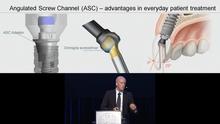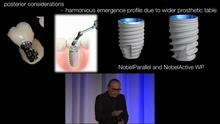-
0
Patient Assessment
- 0.1 Patient Demand
- 0.2 Anatomical location
-
0.3
Patient History
- 2.1 General patient history
- 2.2 Local history
-
0.4
Risk Assessment
- 3.1 Risk Assessment Overview
- 3.2 Age
- 3.3 Patient Compliance
- 3.4 Smoking
- 3.5 Drug Abuse
- 3.6 Recreational Drug and Alcohol Abuse
- 3.7 Condition of Natural Teeth
- 3.8 Parafunctions
- 3.9 Diabetes
- 3.10 Anticoagulants
- 3.11 Osteoporosis
- 3.12 Bisphosphonates
- 3.13 MRONJ
- 3.14 Steroids
- 3.15 Radiotherapy
- 3.16 Risk factors
-
1
Diagnostics
-
2
Treatment Options
-
2.1
Treatment planning
- 0.1 Non-implant based treatment options
- 0.2 Treatment planning conventional, model based, non-guided, semi-guided
- 0.3 Digital treatment planning
- 0.4 NobelClinician and digital workflow
- 0.5 Implant position considerations overview
- 0.6 Soft tissue condition and morphology
- 0.7 Site development, soft tissue management
- 0.8 Hard tissue and bone quality
- 0.9 Site development, hard tissue management
- 0.10 Time to function
- 0.11 Submerged vs non-submerged
- 0.12 Healed or fresh extraction socket
- 0.13 Screw-retained vs. cement-retained
- 0.14 Angulated Screw Channel system (ASC)
- 2.2 Treatment options esthetic zone
- 2.3 Treatment options posterior zone
- 2.4 Comprehensive treatment concepts
-
2.1
Treatment planning
-
3
Treatment Procedures
-
3.1
Treatment procedures general considerations
- 0.1 Anesthesia
- 0.2 peri-operative care
- 0.3 Flap- or flapless
- 0.4 Non-guided protocol
- 0.5 Semi-guided protocol
- 0.6 Guided protocol overview
- 0.7 Guided protocol NobelGuide
- 0.8 Parallel implant placement considerations
- 0.9 Tapered implant placement considerations
- 0.10 3D implant position
- 0.11 Implant insertion torque
- 0.12 Intra-operative complications
- 0.13 Impression procedures, digital impressions, intraoral scanning
- 3.2 Treatment procedures esthetic zone surgical
- 3.3 Treatment procedures esthetic zone prosthetic
- 3.4 Treatment procedures posterior zone surgical
- 3.5 Treatment procedures posterior zone prosthetic
-
3.1
Treatment procedures general considerations
-
4
Aftercare
Angulated Screw Channel system (ASC)
Key points
- The Angulated Screw Channel (ASC) broadens the ability to use a screw retained restorations.
- The ASC is currently available only with specific implants.
The ability to correct implant deviation from the long axis of ideal tooth position with angled abutments and custom abutments is well documented. With the custom abutment it many times results in a cement retained final restoration. Current evidence suggests there may be an association between late implant failure and excess cement. In response to this potential complication, the need to place screw retained restorations even in those instances where implant placement is not ideal, led to the development of the ASC. The system of, the ASC abutment, and Omnigrip driver, angles of up to 25 degrees deviation from path of the abutment screw to the implant channel can be reconciled and torqued to 35ncm. This has become an important tool in the anterior and posterior regions.
In the anterior region, single implant placement many times results in the abutment screw access being approached from the buccal or labial aspect. If a prefabricated angled abutment cannot correct the access by providing a lingual approach, the clinician is forced to use a cement retained restoration, usually with a custom abutment. This not only raises concern about the excess cement but increases the cost of the restoration significantly. If one chooses to place a lingual set screw with a custom abutment and avoid the cement, it also raises the cost and complexity of the restoration.
The ASC allows for the placement of a lingual access by using its unique design and achieve the desired tongue value with the patented Omnigrip driver. The driver design is revolutionary and will provide years of service through its “self healing” tip engagement mechanism. It also assures that the ASC screw will not be stripped.
The same principle is equally important for single implant placement in the posterior region, here not so much for the esthetic value but more importantly for access. Since many times space is a issue not allowing for complete vertical access to the abutment screw, the ability to angle the access channel anteriorly makes placement and torquing a routine clinical procedure. The desired torque values are achieved, and the potential of cement extrusion is eliminated. This approach is all part of the Nobel Posterior solution.
Currently the ASC is only available on all conical connection implants which consists of the the Active and Replace Conical connection product line with the exception of the 3.0 diameter. Additionally the metal connection is a very important attribute as it has a better interface than a zirconia to metal connection.


